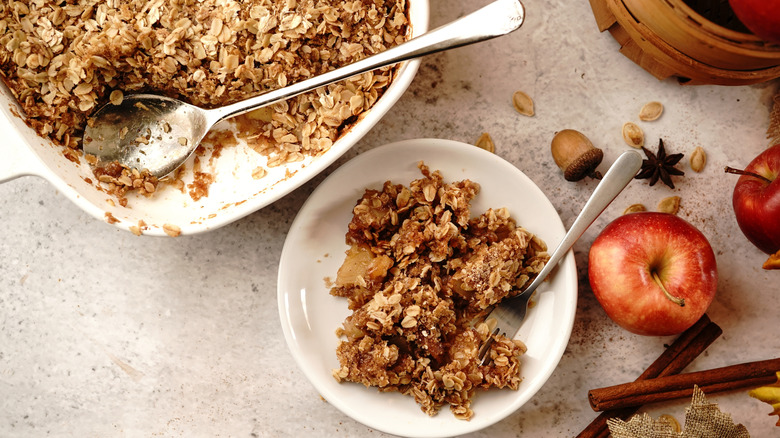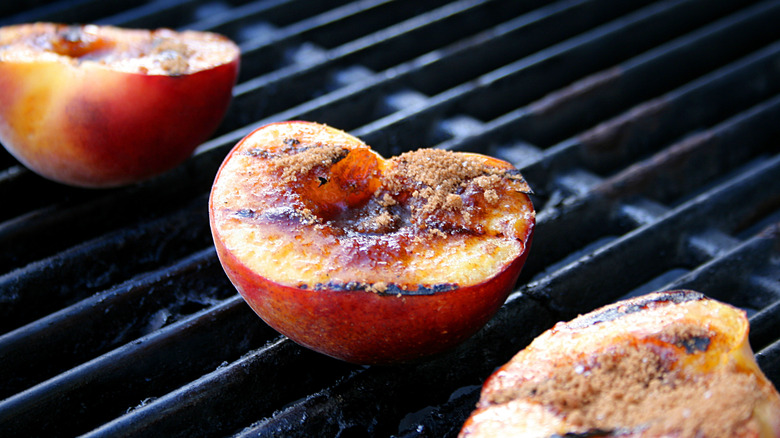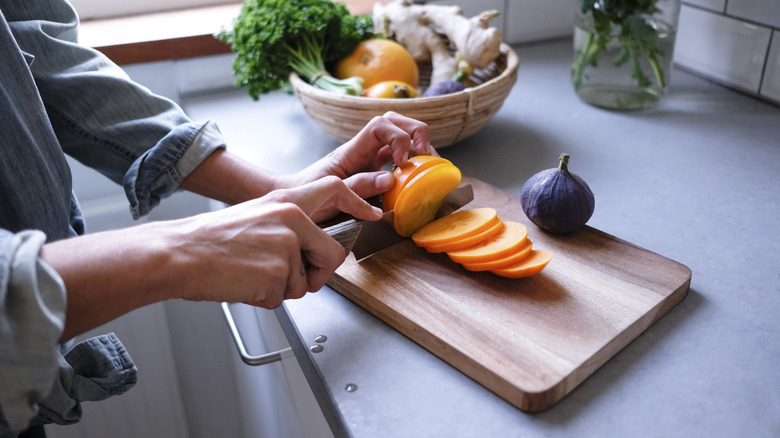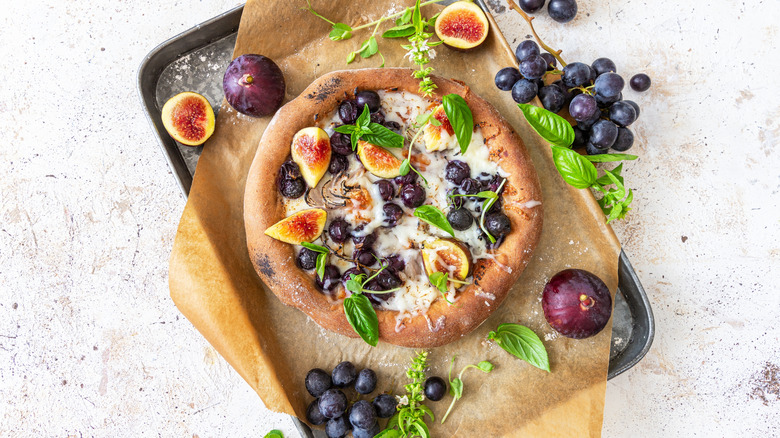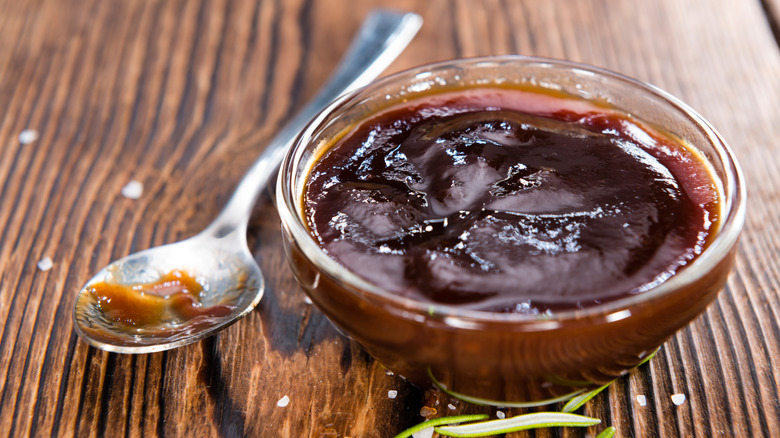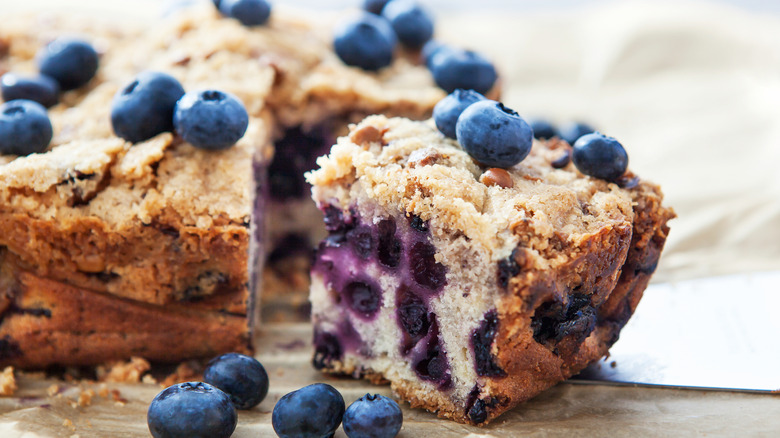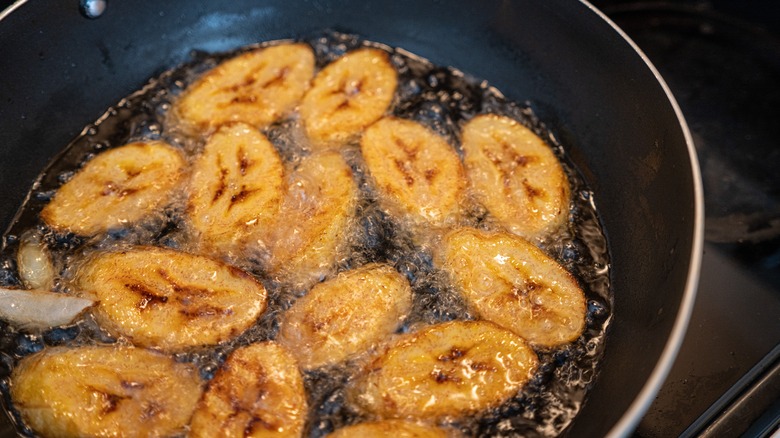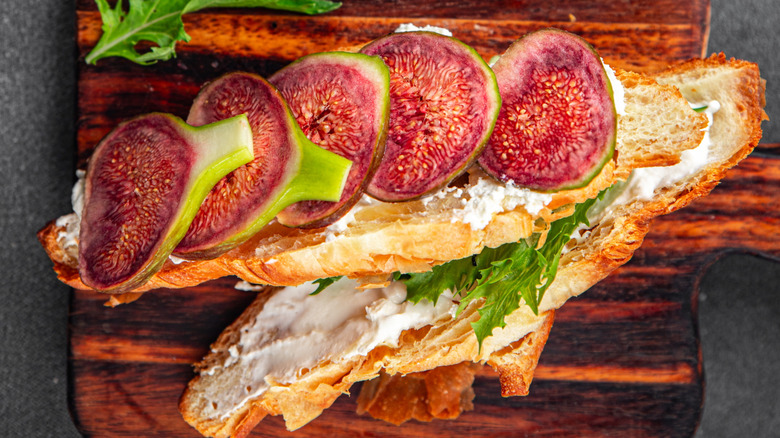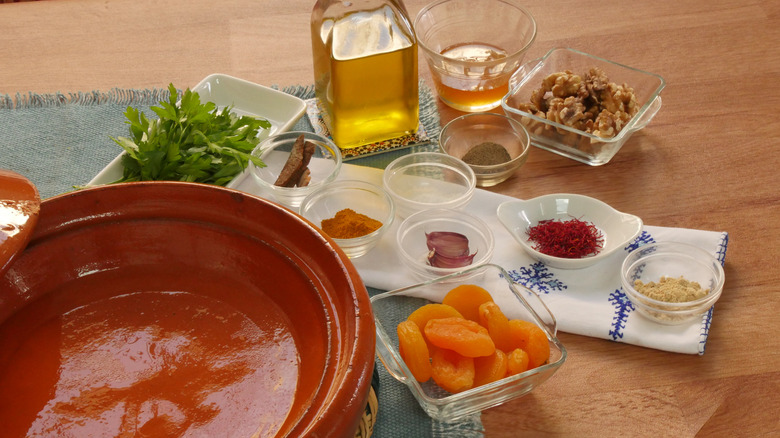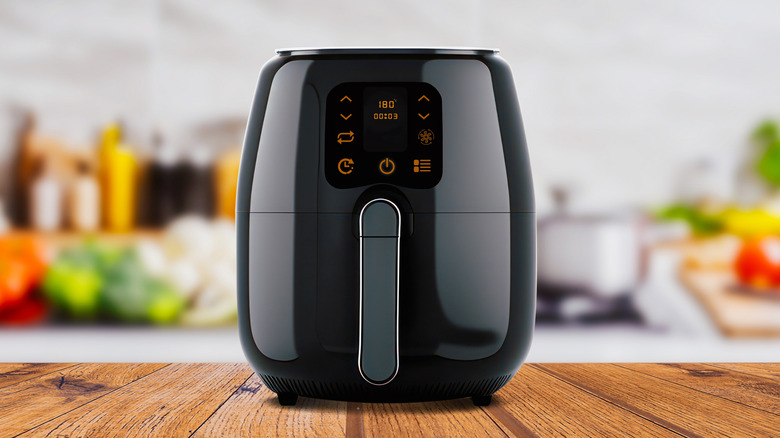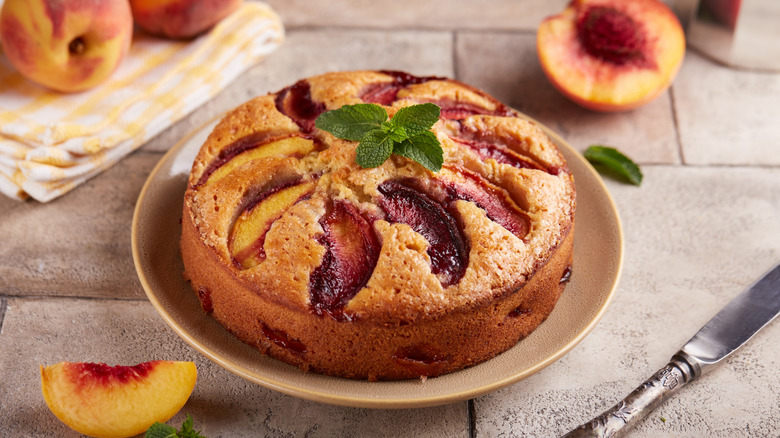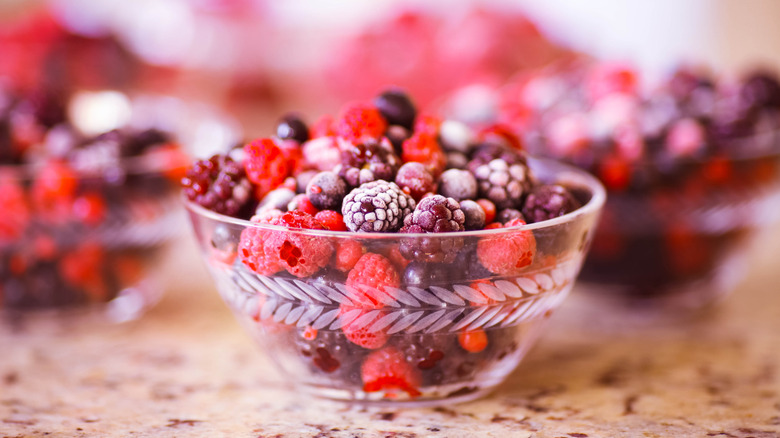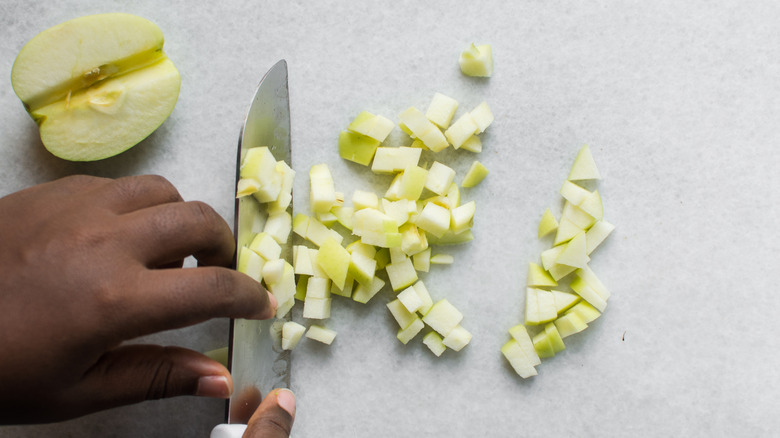Mistakes Everyone Makes When Cooking With Fruit
From crisp apples to juicy peaches, it's no secret that raw fruit is delicious. But, cooking it adds a whole extra dimension to its flavor and gives you more possibilities to use it. The trouble is, there are some mistakes everyone makes when cooking with fruit. This can ruin a dish and put people off cooking fruit altogether. Or, more minor mistakes might just cause a dish not to turn out as well as it could.
Cooking fruit is a great way to use up excess, especially if you grow your own. Or, you might want to cook fruit when you simply haven't got through everything you bought at the grocery store. Most people think of desserts when they consider cooking with fruit — but that's the first mistake. There are many great savory recipes to use it in too. Other common mistakes include letting fruit sink to the bottom of baked goods or switching between fresh and frozen varieties, expecting the same results.
We're going to explore all these missteps and more, examining the problem and how to fix or avoid it. Before you know it, you'll be a pro at cooking with fruit, whether you're taking on desserts or savory dishes.
Only cooking fruit on the stovetop
If you're only cooking fruit on the stovetop — for instance by stewing it or throwing it into pancake batter — you're making a mistake. There are other great ways to cook fruit that produce arguably even more delicious results. Perhaps the most overlooked methods are roasting and grilling.
When you grill or roast your fruit, moisture is driven from it, which concentrates the flavors. When it's done cooking, it's sweeter and fruitier than when it was raw. It might not seem like a grape could taste any grapier — but roast some and find out. The other thing about roasting fruit is that it often caramelizes, giving you richer and more intense flavors. When you grill it, you can expect some charring and a smoky taste. Grilled or roasted fruit is great on pancakes or waffles, in salads, on tacos, or even served simply with vanilla ice cream.
It's easy to overcook fruit when grilling it, though. Be careful not to treat it like meat — it only needs a few minutes on the grill so it's lightly charred on the outside. It doesn't need to be cooked through or it could end up sticky and jammy if it's on the heat for too long.
Cutting fruit too small when grilling it
Now that you know about the beauty of grilling fruit, you'll want to avoid a common mistake people make with this cooking method. Cutting fruit into pieces that are too small can cause a number of problems. You should think carefully about the size of the chunks you cut your fruit — some won't need cutting at all.
When you dice fruit or slice it thinly, it may not be able to keep its structure as it shrinks and breaks down from the heat. It may also cook through too quickly, ending up overcooked on the inside by the time it's sufficiently browned on the outside. What's more, if you chop fruit into very small pieces, it will probably fall through the grill while you're cooking it.
Stone fruits, such as peaches and plums, are often best halved with the pit removed. Bananas can be grilled whole, and some people even leave them in their peel as they cook. Other fruits, such as strawberries or grapes, may be too small even to grill whole. A good solution is to grill them on a skewer so they don't fall through the grate.
Thinking fruit is only good for sweet recipes
If you only use fruit in desserts or snacks, you're making a mistake. It can add amazing flavors to savory dishes too, bringing a twist to familiar recipes. Plus, there are many savory recipes that traditionally use fruit, anyway. If you love a sweet and salty combination, you'll probably like fruit in this context. You might be surprised at how well it works in meals you wouldn't expect.
There are all kinds of savory recipes with a fruity twist. Let's start with salads; adding fruit gives them a sweet kick. Try tossing sliced apples or pears into your green salad. Mandarin oranges go great with spinach, and sprinkling pomegranate seeds over any type of salad is never a bad idea. Fruit balances out bitter greens, adds some texture, and brings a sweetness that's often missing in salads.
Stir-fries are another dish where fruit shines. Chunks of pineapple or mango bring an intense sweetness that balances out the savory notes of ingredients like soy sauce and the acidity of citrus juice or vinegar. Plus, heat caramelizes the fruit, making it extra tasty. Of course, there's the controversial pineapple on pizza, too. But if that's not your bag, you might prefer sliced fig, peach, or pear on pizza to contrast the rich savory notes of the cheese. The same topping combinations work on other flatbreads or on sheets of puff pastry to make a kind of open tart.
Not cooking fruit into savory sauces
When you consider turning fruit into a sauce, you probably think about sweet compotes or fruit sauces to drizzle over ice cream. What many people overlook is that fruit is delicious cooked into savory sauces. Fruit-based barbecue sauces are fairly common because barbecue sauce is already sweet. Using fruit can cut down the need for refined sugar and it brings extra flavor to the table. Mango, peach, and pineapple are common additions to barbecue sauce, but many fruits work, including apple and blueberry.
Meanwhile, berries go well with balsamic vinegar, as the sweetness of the fruit goes brilliantly with the mild tartness of the vinegar. If you haven't tried pairing it with strawberries yet, you're surely becoming part of the minority. You can use this combo to create tasty sauces, such as blueberry-balsamic or blackberry-balsamic.
But, that's not where your sauce options end. You could grill pineapple or mango to add to a salsa or cook fruits into ketchup. If you've ever wondered what a British brown sauce is, apples are among the key ingredients. And, let's not forget the world of chutneys. They're more condiments than sauces, but there are countless fruit chutney recipes to choose from.
Letting fruit sink in baked goods
A common error when baking cakes or muffins with chunks of fruit or whole berries in them is letting the fruit sink to the bottom. The goal is to have the fruit evenly distributed so that you get some in every bite. When it's concentrated in one spot, the top can be dry and lack flavor, while the bottom is too wet and fruity.
The reason why your fruit is sinking in your bake is that it's too wet. All fruit introduces moisture into baked goods, but when it's too moist, the fruit can end up sinking right to the bottom. It's particularly common with frozen fruit that's only been partially defrosted. If you think this might be what's happening with your bakes, either use fresh fruit or fully defrost it before adding it to your batter. It's also common when fresh fruit is extremely ripe, which is why it's sometimes better to bake with slightly under-ripe or just-ripe produce.
Another tip to keep fruit from sinking is to toss it in flour before adding it to the batter. This extra layer thickens the batter directly around the fruit, stopping it from sinking. Since you aren't introducing enough flour to affect the texture or flavor of the bake, it will come out just as tasty as usual.
Sticking to the same old fruits
It's easy to fall into the habit of cooking with the same fruits over and over again — apples, bananas, pears, peaches. Sure, they're tasty, but sticking to them all the time can get boring. Instead, you should look beyond the everyday fruits you find in every grocery store and pick something that's lesser-used in the U.S.
Take plantains, for example. They look like bananas but are usually cooked like vegetables. You can fry them, mash them, or bake them into chips. You can even turn plantain into pizza crust. You don't want to miss out on cooking with jackfruit either, which is a fantastic meat substitute because of its texture. Ackee is another fruit worth trying. It's often paired with saltfish in Jamaican cooking and has a slightly nutty flavor.
You might also want to try cooking with persimmons, an orange fruit shaped like a tomato. When ripe, they're super sweet and great in baked goods or sliced up in salads. Then, there are gooseberries, which aren't as sweet as other berries but work great in crisps and crumbles that have enough sugar to balance out their tartness.
Leaving fruit out of sandwiches
Leaving fruit out of sandwiches is a big mistake. A huge one. You might think it doesn't belong in a sandwich, but you'd be surprised how good it can be. It adds another layer of flavor and introduces sweetness to balance out the savory, umami ingredients often found in sandwiches, such as meats and cheeses.
One great way to use fruit in sandwiches is to add grilled pineapple rings. The sweet, juicy component balances out salty ingredients, whereas grilling it concentrates the flavors and infuses a subtle smokiness. Sliced figs are another great option. They're sweet and flavorful, especially when perfectly ripe. They work well with strong flavors like goat cheese and blue cheese. You could also try adding thin apple slices to a sandwich for a crisp texture, much like iceberg lettuce.
Have you ever heard of quince paste? Store-bought or homemade, the spread is made from quince fruit and can be used like jam in your sandwiches. It goes well with cheese sandwiches, especially those with sharp cheddar. Don't forget about classic combinations like peanut butter and banana.
Ignoring dried fruits
Think that cooking with fruit extends to the fresh stuff only? Well, it's absolutely a mistake to ignore dried fruits. There are so many excellent dried fruit recipes, both sweet and savory, and you'd be foolish to ignore them.
If you want an intense experience, fruit cake is a great place to start. It's basically mostly dried fruit stuck together with a few crumbs of cake. It's certainly not for everyone, but perfect for a dried fruit aficionado. There are also traditional British baked goods that use dried fruit, including spotted dick and Welsh cakes. You don't have to just think of raisins when using dried fruit, either — throw semi-dried apples into a muffin batter or dried cherries into a loaf cake.
But, what about savory recipes? Moroccan tagines traditionally include dried apricots, while dried raisins or cranberries are great in pilafs. Dried fruits are great in salads too, and if you take some liberties and count sun-dried tomatoes in the ranks of dried fruits, then you have plenty more options.
Not using an air fryer to cook fruits
You probably never thought to cook fruit in an air fryer, but you definitely should. While you might usually think of the kitchen appliance for cooking foods like fries or chicken, it also works great for fruits. As it circulates hot air, the fruits caramelize on the outside while remaining soft and juicy on the inside. You can experiment with different fruits to find your favorites.
Apples are a popular choice. Just slice them up, sprinkle with cinnamon, and air fry until they're soft and golden. You'll get a sweet, warm treat that's a bit like baked apples, but quicker. Bananas are another great option. Cut them into slices, air fry them, and they'll crisp slightly — or air fry them in their skin for gooier results. Pineapple works well too, becoming caramelized and even sweeter after spending awhile in the air fryer. Stone fruits like peaches and plums are also great air fried.
Cooking times vary depending on the fruit and the size of the pieces, so check on them during cooking. You can add sugar for extra sweetness or warm spices, like cinnamon, nutmeg, and ginger. And if you're wondering how to serve it, air fried fruit is delicious with a scoop of quality vanilla ice cream.
Baking with overripe fruit
You might think that the sweeter and juicier the better when you're baking with fruit. However, in some cases using the super ripe stuff is a mistake. You might be better off sticking with fruit that's under-ripe or only just turned ripe.
The reason for this is that very ripe fruit releases a lot of moisture as it bakes. If you haven't adjusted for this by making a thicker batter (which can be tricky unless you're a baking pro), then it can wreak havoc. The excess juice released by overripe fruit means the batter ends up wetter than it should be. This can lead to dense cakes, an improper rise, or sinking in the middle. The simple solution is to use fruit that's slightly underripe. The bonus is that it makes fruit that would have otherwise been a bit bland tastier.
Of course, there are some exceptions. For instance, when you're baking banana bread, you should ideally use overripe bananas. The blacker and gnarlier the peel looks, the sweeter and more banana-y the fruit inside, which makes for perfect banana bread.
Switching fruit varieties or using frozen fruits in place of fresh in baked goods
You might think that you could easily switch the type of fruit in a recipe. After all, what does it matter if you use apples or peaches? Or perhaps you want to try fresh fruit instead of frozen or vice versa. But doing this is likely to cause a baking mishap. There are too many variables at play here and it can make things go awry.
So, why can't you just switch one fruit for another? Well, it's not that you absolutely can't, but you have to think about what you're doing. If a recipe calls for apples and you use plums instead, you'll introduce extra moisture that can mess up the recipe. However, if you switched the apple in a recipe for a quince or a firm pear, you shouldn't run into any trouble. Ultimately, if you must switch one fruit for another, choose a fruit with a similar texture and moisture content.
The trouble with using frozen fruit instead of fresh is similar — it can have a different moisture content, which affects the recipe. It's best to stick to fresh fruit when recipes specify it and frozen fruit in bakes that call for that. However, if you only have access to frozen fruit, letting it defrost first reduces the amount of excess liquid it releases into the batter.
Underutilizing citrus fruits in cooking
Citrus fruit can improve almost any dish, which is why underutilizing it is a mistake. You might not think of squeezing lemon juice into a pot of stew as cooking with fruit, but it is. And, it's something you shouldn't overlook. The reason citrus boosts practically any dish is because of its acidity. It balances out sweetness and cuts through savory notes. When dishes taste dull or flat, you'd be amazed how much difference some citrus can make.
Between lemon, lime, grapefruit, and orange, there's a citrus fruit that works for most dishes. Lime, for instance, is great in Mexican recipes but would taste weird in most pasta dishes. Lemon is generally the citrus fruit of choice for Italian cuisine. Then, there are lesser-used citrus fruits, such as yuzu or bergamot, for anyone who wants to branch out and get adventurous.
The beauty of citrus fruit is that it works well in most savory dishes, from a splash of lime in a stir-fry or grapefruit in a salad dressing, to freshly squeezed orange juice or zest in a marinade. However, it's also great in sweet goods. Lemon and poppyseed muffins, zingy key lime pie, or chocolate orange cookies are just the start.
Cutting fruit into uneven pieces when cooking or baking with it
It's okay to take a haphazard approach to cooking sometimes. However, when you're cooking or baking with fruit, you should try to chop it as uniformly as possible. Unevenly cut pieces can cause issues. What you want to avoid is having some pieces of fruit that are firm or crunchy and other pieces that are so soft they practically melt away in the dish. Unfortunately, that is exactly what you'll get if you cut it into uneven pieces. Fruit softens as it cooks and small pieces soften faster than large ones, so uniformity is important.
We're not saying you need to measure every piece of fruit but you should at least aim for similar sizes. A small difference here or there is okay. However, if some pieces are an inch across and others are half that, you'll run into trouble.
